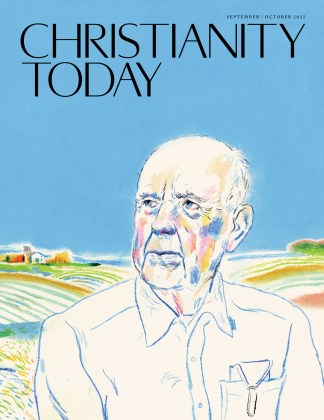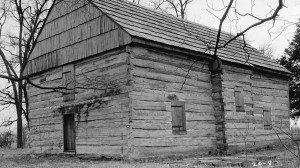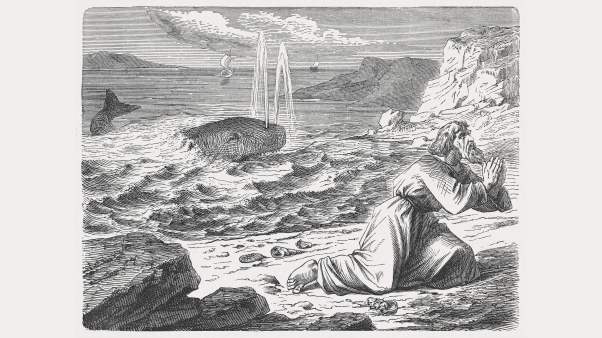In this series
Friday, August 6, 1801—wagons and carriages bounced along narrow Kentucky roads, kicking up dust and excitement as hundreds of men, women, and children pressed toward Cane Ridge, a church about 20 miles east of Lexington. They hungered to partake in what everyone felt was sure to be an extraordinary “Communion.”
By Saturday, things were extraordinary, and the news electrified this most populous region of the state; people poured in by the thousands. One traveler wrote a Baltimore friend that he was on his way to the “greatest meeting of its kind ever known” and that “religion has got to such a height here that people attend from a great distance; on this occasion I doubt not but there will be 10,000 people.”
He underestimated, but his miscalculation is understandable. Communions (annual three-to-five-day meetings climaxed with the Lord’s Supper) gathered people in the dozens, maybe the hundreds. At this Cane Ridge Communion, though, sometimes 20,000 people swirled about the grounds—watching, praying, preaching, weeping, groaning, falling. Though some stood at the edges and mocked, most left marveling at the wondrous hand of God.
The Cane Ridge Communion quickly became one of the best-reported events in American history, and according to Vanderbilt historian Paul Conkin, “arguably … the most important religious gathering in all of American history.” It ignited the explosion of evangelical religion, which soon reached into nearly every corner of American life. For decades the prayer of camp meetings and revivals across the land was “Lord, make it like Cane Ridge.”
What was it about Cane Ridge that gripped the imagination? Exactly what happened there in the first summer of the new century?
Egyptian Darkness
Five years earlier, few would have predicted the Cane Ridge revival. Since the American Revolution, Christianity had been on the decline, especially on the frontier. Sporadic, scattered revivals—in Virginia in 1787–88, for example—dotted the landscape, but they were short-lived. Religious indifference seemed to be spreading.
On a trip to Tennessee in 1794, Methodist bishop Francis Asbury wrote anxiously about frontier settlers, “When I reflect that not one in a hundred came here to get religion, but rather to get plenty of good land, I think it will be well if some or many do not eventually lose their souls.”
Andrew Fulton, a Presbyterian missionary from Scotland, discovered in Nashville and in “all the newly formed towns in this western colony, there are few religious people.” The minutes of the frontier Transylvania Presbytery reveal deep concern about the “prevalence of vice & infidelity, the great apparent declension of true vital religion in too many places.”
Rampant alcoholism and avaricious land-grabbing were matched by the increasing popularity of both universalism (the doctrine that all will be saved) and deism (the belief that God is uninvolved in the world). Methodist James Smith, traveling near Lexington in the autumn of 1795 feared that “the universalists, joining with the Deists, had given Christianity a deadly stab hereabouts.”
Hyperbole, perhaps. Still, during the six years preceding 1800, the Methodist Church—most popular among the expanding middle and lower classes—declined in national membership from 67,643 to 61,351. In the 1790s the population of frontier Kentucky tripled, but the already meager Methodist membership decreased.
Churches and pastors did not merely wring their hands; they clasped them in prayer—at prayer meetings, at worship, and at national conventions. In 1798 the Presbyterian General Assembly asked that a day be set aside for fasting, humiliation, and prayer to redeem the frontier from “Egyptian darkness.”
Church discipline was thrown into high gear. Church minute books record those excluded from fellowship for alcoholism, profanity, mistreatment of slaves, and sexual immorality. Some congregations were so exacting, they decimated their ranks. No matter, they said; sinning had to be stopped in order that God might again bless.
Divine Flame
All this anxiety, prayer, and discipline, though, were grounded in hope. None was sure when or where it would begin, but many were convinced that God would begin his work of revival. James Smith, after traveling through Kentucky, wrote, “I trust he [God] will yet bring good out of this evil, and that the glory of scriptural religion, [though] obscure for the present, will shine forth hereafter with redoubled luster.”
The “glory of scriptural religion” began to “shine forth” in Kentucky when James McGready arrived in Logan County in 1798 to pastor three small congregations: the Red River, Gaspar River, and Muddy River churches. He brought with him from North Carolina a well-deserved reputation for fiery preaching. He was a large, imposing man with piercing eyes and a voice coarse and tremulous. Barton Stone, pastor of the Cane Ridge Church, said of McGready after hearing him preach, “My mind was chained by him, and followed him closely in his rounds of heaven, earth, and hell with feelings indescribable.”
McGready’s preaching so stirred his congregations that when the Red River church sponsored its annual Communion in June 1800, the spiritual climate was charged. Local ministers were invited to participate, as were Presbyterian William McGee and his Methodist brother John, whose preaching had been exciting churches in Tennessee.
Friday, Saturday, and Sunday passed quietly and reverently—as these Presbyterian Communions were wont to go. On Monday, though, as one local minister preached, a woman who had long sought assurance for her salvation began shouting and singing. The preacher concluded his sermon, and all the ministers left the church—except for the McGee brothers. Presbyterian William sat on the floor near the pulpit and began weeping. Soon the congregation was weeping, seeking full security for salvation.
Methodist John rose to preach; a witness said he exhorted people to let “the Lord God omnipotent reign in their hearts, and to submit to him.” People began to cry and shout.
Then the woman who had first started shouting let out a shrill of anguish. Methodist John McGee, seemingly entranced, made his way to comfort her. Someone (probably his Presbyterian brother) reminded him this was a Presbyterian church; the congregation would not condone emotionalism! Later John recalled, “I turned to go back and was near falling; the power of God was strong upon me. I turned again and, losing sight of the fear of man, I went through the house shouting and exhorting with all possible ecstasy and energy, and the floor was soon covered with the slain”—people were falling in ecstasy.
The News Spreads
McGready and the other ministers, convinced this was the work of God, laid plans for another sacramental service, to be held at the Gaspar River Church the following month. McGready took pains to circulate the news, but a media campaign was hardly necessary. Speaking of the hundreds who flocked to Gaspar River, one minister said, “The news of the strange operations which had transpired at the previous meeting had run throughout the country in every direction, carrying a high degree of excitement to the minds of almost every character.”
More people began arriving than could be accommodated by the host church’s families, but most came prepared to encamp. (Though large outdoor meetings had a long history, this was probably the first “camp meeting”—though the term was not coined for another two years.)
Friday and most of Saturday passed in a solemn manner, but on Saturday night, just after the last sermon was finished, two women began talking excitedly about how God had entered them, and soon, wrote McGready, “Sinners [were] lying powerless in every part of the house, praying and crying for mercy.” All night long, ministers attended to distressed and desperate penitents.
Sunday morning’s sermon also evoked groans and cries, and at night, with the pulpit illumined by flaming torches, William McGee exhorted with all the energy and oratory he could muster. “Towards the close of the sermon, the cries of the distressed arose almost as loud as his voice,” McGready wrote. “After the congregation was dismissed the solemnity increased. … No person seemed to wish to go home—hunger and sleep seemed to affect nobody—eternal things were the vast concern.”
In the succeeding months, camp meeting revivals spread through Kentucky and Tennessee: at Muddy River, Mr. Craighead’s church, Clay-lick, Little Muddy Creek, Montgomery’s Meetinghouse, and Hopewell. Each seemed more dramatic than the last. As 1800 drew to a close, John McGee reported that at Desha’s Creek, “Many thousands of people attended. The mighty power and mercy of God was manifested. The people fell before the Word, like corn before a storm of wind, and many rose from the dust with divine glory shining in their countenances.”
“The excitement created by these reports,” recalled Methodist James B. Finley, “was of the most intense and astonishing character.” The movement was marked by “some peculiarities” he admitted, and then added, “The nearest approximation to it … was the revival on the day of Pentecost.”
Revival Comes to Cane Ridge
Presbyterian Barton W. Stone, pastor of the Concord and Cane Ridge churches, traveled to witness one of these revivals for himself. He returned in that spring of 1801 overwhelmed.
“The scene to me was new and passing strange. … Many, very many fell down, as men slain in battle, and continued for hours together in an apparently breathless and motionless state—sometimes for a few moments reviving, and exhibiting symptoms of life by a deep groan, or piercing shriek, or by a prayer for mercy most fervently uttered. … With astonishment did I hear men, women, and children declaring the wonderful works of God.”
When he described his experiences to the Cane Ridge Church, the congregation was “affected with awful solemnity, and many returned home weeping.” That evening, when he spoke at the Concord church, two little girls fell in a faint. After a brief revival ensued at Concord, Stone scheduled a Communion at Cane Ridge the first weekend in August.
The Cane Ridge meeting house sat on the gentle slopes of a large hill covered with bamboo—the cane that gave the ridge its name—and scattered clumps of trees. The simple meeting house could hold 500 (standing room), but the congregation had recently erected a large tent, perhaps to accommodate the anticipated crowds.
But as Friday, August 6 ensued, it was clear no one had adequately anticipated the numbers. The Cane Ridge families opened their homes to the neighboring families who customarily attended the annual Cane Ridge Communion. Wealthier families might take in three or four such families; still, children and even adults had to sleep on the floor or in barns. A dozen people might sleep in a single room in a small cabin. Some thoughtful farmers left fields unpastured or left hay uncut in order to feed visitors’ horses. But as the visitors grew from hundreds into thousands, local hospitality was swamped. Many visitors had to find lodging miles away, though some came prepared to camp.
Friday evening it rained, which held back the crowds, but still the meetinghouse was packed. Barton Stone, as host pastor, probably gave the opening welcome, followed by a sermon by Matthew Houston, a colleague. The air was thick with expectancy, but nothing extraordinary occurred, though some lingered all night in prayer.
Sabotaged Saturday
At a typical Communion, Saturday was mostly devoted to fasting and small-group prayer as people solemnly prepared themselves for Sunday’s Communion. The growing mob, which now numbered in the thousands, sabotaged the routine.
The Saturday morning services had been quiet—the proverbial lull before a storm. But by afternoon, the preaching was continual, from both the meetinghouse and the tent. One wild, young minister, Richard McNemar, proclaimed in ecstacy a “true new gospel,” an expression that startled some ministers but fascinated the crowds. Excitement mounted, and amid smoke and sweat, the camp erupted in noise: the cries and shouts of the penitent, the crying of babies, the shrieking of children, and the neighing of horses.
Then the tumultuous bodily “exercises” began. Along with the shouting and crying, some began falling. Some experienced only weakened knees or a light head (including Governor James Garrard). Others fell but remained conscious or talkative; a few fell into a deep coma, displaying the symptoms of a grand mal seizure or a type of hysteria. Though only a minority fell, some parts of the grounds were strewn like a battlefield.
Some were attended to where they fell; others were carried to a convenient place, where people would gather around them to pray and sing hymns. “If they [the fallen] speak,” one reported, “what they say is attended to, being very solemn and affecting—many are struck under such exhortations.”
Then something even more strange occurred, later to be called “the jerks.” One witness described those afflicted: “Their heads would jerk back suddenly, frequently causing them to yelp, or make some other involuntary noise. … Sometimes the head would fly every way so quickly that their features could not be recognized. I have seen their heads fly back and forward so quickly that the hair of females would be made to crack like a carriage whip, but not very loud.”
As dark descended, camp fires cast large shadows against the trees; candles, lamps, and torches illumined the camp as hundreds moved to and fro, “like Gideon’s army”; preachers shouted sermons from the tent as people exhorted from the ground; some chanted hymns, others ecstatic hosannas—and always the mournful wailing for sin. “The noise was like the roar of Niagara,” wrote a participant. “The vast sea of human beings seemed to be agitated as if by a storm.”
The most extravagant exercises were mocked at this and later revivals, even though they were restricted to a relative few. Still, by Saturday evening, even the ministers were troubled by the tumult. None were opposed to the exercises per se, but some, like John Lyle, believed it wrong for preachers to coax such emotionalism by hysterical preaching. Lyle was especially puzzled by Barton Stone, the host pastor. He was not a wild preacher, like some, but he did nothing to restrain the wilder preachers.
The distress and confusion were so widespread even the young enthusiast McNemar was worried. Lyle, McNemar, and Matthew Houston started preaching unscheduled nighttime sermons from the tent, which helped calm the crowds. But they didn’t lower the level of spiritual anxiety.
Confusion Reigns
Early Sunday morning, relative calm reigned, though some had been up most of the night. The central purpose of the gathering—the Communion—took place as scheduled in the meetinghouse. The minister of a nearby congregation preached the traditional sermon outside, and then those with Communion tokens went inside for the sacrament. The tables, set up in the shape of a cross in the aisles, could probably accommodate 100 at a time. Over the ensuing hours, hundreds were served. Lyle wrote that he had “clearer views of divine things than … before” as he partook, and that he felt “uncommonly tender” as he spoke.
Still, it must have been a distracted Communion for the Presbyterians, for outside the tumult began again. Some Methodists resented their exclusion from the meetinghouse and the tent. So William Burke, one of Methodism’s most powerful and esteemed preachers, planted himself on a fallen tree, fifteen feet above ground, and began Methodist services. His opening prayers and hymns alone gained him a huge audience.
Burke’s was but one of four centers of activity, including the tent, the meetinghouse, and an assembly of blacks that met apart. In addition, dozens of informal prayer groups clustered at camp sites. Although only ministers preached prepared sermons, literally hundreds of people became spontaneous exhorters, excitedly giving spiritual advice or tearful warnings. Almost anyone—women, small children, slaves, the shy, the illiterate—could exhort with great effect.
One 7-year-old girl mounted a man’s shoulders and spoke wondrous words until she was completely fatigued. When she lay her head on his as if to sleep, someone in the audience suggested “the poor thing” had better be laid down to rest. The girl roused and said, “Don’t call me poor, for Christ is my brother, God my father, and I have a kingdom to inherit, and therefore do not call me poor, for I am rich in the blood of the Lamb!”
Exhortations increased, the moaning more intense. Hymn singing, which affected people most deeply, became even louder. Unrestrained exercises resumed. Preachers could hardly be heard. Confusion reigned:
“Sinners dropping down on every hand, shrieking, groaning, crying for mercy, convoluted,” one witness said, “professors [believers] praying, agonizing, fainting, falling down in distress for sinners, or in raptures of joy! Some singing, some shouting, clapping their hands, hugging and even kissing, laughing; others talking to the distressed, to one another, or to opposers of the work, and all this at once.”
Fatigued ministers were in constant demand to attend the slain, to pray with the distressed, and to calm the hysterical. As dark descended and the night grew late, the cacophony continued and then began to trail off. Still, some stayed up all night, grabbing sleep whenever they could, arising later for more prayer and exhortation and singing.
Beyond Calculation
By Monday, food and supplies were running short, and appointments had to be kept, forcing many families to cut short their stay. But the momentum could not be stopped. Arrivals, some coming from great distances after hearing of the revival, continued to flood the grounds. Ministers who had gone home to preach at their churches on Sunday returned to minister to the many people in distress.
For four more days, the singing, praying, preaching, and falling continued, slowly dribbling to a stop on Thursday.
Few could comprehend, let alone describe, what had happened. Barton Stone said, “A particular description of this meeting would fill a large volume, and then the half would not be told.”
Nor could anyone get a handle on the numbers. Estimates of attendance ran between 10,000 and 25,000; estimates of the slain from 1,000 to 3,000; estimates of those who took Communion from 800 to 3,000; estimates of conversions, from 1,000 to 3,000.
This much is clear. Religion suddenly became the talk of the region and nation. Traveling to Lexington a year later, one man reported that he heard “little else than the great revival of religion.” Such was the continued enthusiasm, he said he “felt much anxiety lest I should fall down when amongst them”!
Face to Face
In many ways, Cane Ridge was a very human affair. At times, emotional excess reigned, and the revival split denominations and gave birth to not a few sects. It’s also clear, as historians have shown, that powerful social and cultural forces played a large role at Cane Ridge.
Yet the Christian historian cannot help but see something else at work. What appeared at Cane Ridge looks startlingly like the events of the Great Awakening of the 1740s, and of the revivals in medieval Europe, and of the day of Pentecost in first-century Jerusalem. All were moments when people fell and whirled and praised and groaned, when faith and culture and passion were tossed together in a wild, messy, and unimaginable way—when people, at least momentarily, no longer saw God through a glass darkly but face to face.
Mark Galli is managing editor of Christian History.
Copyright © 1995 by the author or Christianity Today/Christian History magazine. Click here for reprint information on Christian History.














